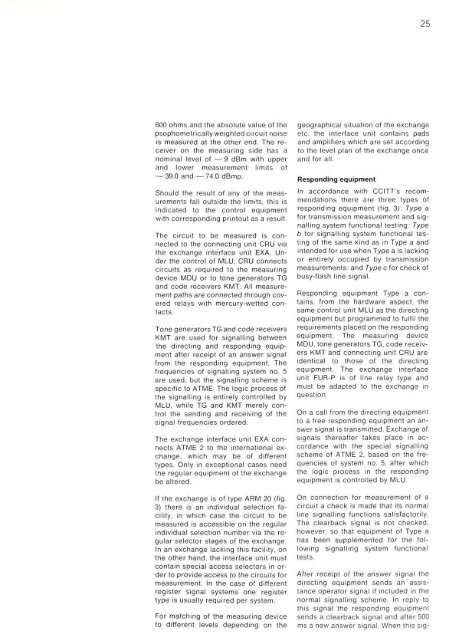electronic telephone sets coaxial cable systems - The history of ...
electronic telephone sets coaxial cable systems - The history of ...
electronic telephone sets coaxial cable systems - The history of ...
Create successful ePaper yourself
Turn your PDF publications into a flip-book with our unique Google optimized e-Paper software.
600 ohms and the absolute value <strong>of</strong> the<br />
psophometricallyweighted circuit noise<br />
is measured at the other end. <strong>The</strong> receiver<br />
on the measuring side has a<br />
nominal level <strong>of</strong> —9 dBm with upper<br />
and lower measurement limits <strong>of</strong><br />
— 39.0 and — 74.0 dBmp.<br />
Should the result <strong>of</strong> any <strong>of</strong> the measurements<br />
fall outside the limits, this is<br />
indicated to the control equipment<br />
with corresponding printout as a result.<br />
<strong>The</strong> circuit to be measured is connected<br />
to the connecting unit CRU via<br />
the exchange interface unit EXA. Under<br />
the control <strong>of</strong> MLU, CRU connects<br />
circuits as required to the measuring<br />
device MDU or to tone generators TG<br />
and code receivers KMT. All measurement<br />
paths are connected through covered<br />
relays with mercury-wetted contacts.<br />
Tone generators TG and code receivers<br />
KMT are used for signalling between<br />
the directing and responding equipment<br />
after receipt <strong>of</strong> an answer signal<br />
from the responding equipment. <strong>The</strong><br />
frequencies <strong>of</strong> signalling system no. 5<br />
are used, but the signalling scheme is<br />
specific to ATME. <strong>The</strong> logic process <strong>of</strong><br />
the signalling is entirely controlled by<br />
MLU, while TG and KMT merely control<br />
the sending and receiving <strong>of</strong> the<br />
signal frequencies ordered.<br />
<strong>The</strong> exchange interface unit EXA connects<br />
ATME 2 to the international exchange,<br />
which may be <strong>of</strong> different<br />
types. Only in exceptional cases need<br />
the regular equipment <strong>of</strong> the exchange<br />
be altered.<br />
If the exchange is <strong>of</strong> type ARM 20 (fig.<br />
3) there is an individual selection facility,<br />
in which case the circuit to be<br />
measured is accessible on the regular<br />
individual selection number via the regular<br />
selector stages <strong>of</strong> the exchange.<br />
In an exchange lacking this facility, on<br />
the other hand, the interface unit must<br />
contain special access selectors in order<br />
to provide access to the circuits for<br />
measurement. In the case <strong>of</strong> different<br />
register signal <strong>systems</strong> one register<br />
type is usually required per system.<br />
For matching <strong>of</strong> the measuring device<br />
to different levels depending on the<br />
geographical situation <strong>of</strong> the exchange<br />
etc. the interface unit contains pads<br />
and amplifiers which are set according<br />
to the level plan <strong>of</strong> the exchange once<br />
and for all.<br />
Responding equipment<br />
25<br />
In accordance with CCITT's recommendations<br />
there are three types <strong>of</strong><br />
responding equipment (fig. 3): Type a<br />
for transmission measurement and signalling<br />
system functional testing: Type<br />
b for signalling system functional testing<br />
<strong>of</strong> the same kind as in Type a and<br />
intended for use when Type a is lacking<br />
or entirely occupied by transmission<br />
measurements: and Type c for check <strong>of</strong><br />
busy-flash line signal.<br />
Responding equipment Type a contains,<br />
from the hardware aspect, the<br />
same control unit MLU as the directing<br />
equipment but programmed to fulfil the<br />
requirements placed on the responding<br />
equipment. <strong>The</strong> measuring device<br />
MDU, tone generators TG, code receivers<br />
KMT and connecting unit CRU are<br />
identical to those <strong>of</strong> the directing<br />
equipment. <strong>The</strong> exchange interface<br />
unit FUR-P is <strong>of</strong> line relay type and<br />
must be adapted to the exchange in<br />
question.<br />
On a call from the directing equipment<br />
to a free responding equipment an answer<br />
signal is transmitted. Exchange <strong>of</strong><br />
signals thereafter takes place in accordance<br />
with the special signalling<br />
scheme <strong>of</strong> ATME 2, based on the frequencies<br />
<strong>of</strong> system no. 5, after which<br />
the logic process in the responding<br />
equipment is controlled by MLU.<br />
On connection for measurement <strong>of</strong> a<br />
circuit a check is made that its normal<br />
line signalling functions satisfactorily.<br />
<strong>The</strong> clearback signal is not checked,<br />
however, so that equipment <strong>of</strong> Type a<br />
has been supplemented for the following<br />
signalling system functional<br />
tests.<br />
After receipt <strong>of</strong> the answer signal the<br />
directing equipment sends an assistance<br />
operator signal if included in the<br />
normal signalling scheme. In reply to<br />
this signal the responding equipment<br />
sends a clearback signal and after 500<br />
ms a new answer signal. When this sig-
















